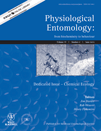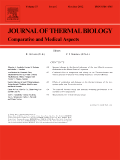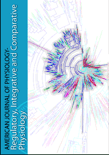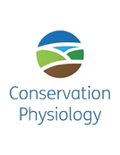
Journal of Comparative Physiology B-Biochemical Systems and Environmental Physiology
Scope & Guideline
Unlocking the Secrets of Biochemical Systems in Nature
Introduction
Aims and Scopes
- Physiological Adaptations to Environmental Stressors:
Research in this area investigates how various species adapt their physiological processes to cope with extreme environmental conditions such as hypoxia, temperature fluctuations, and salinity changes. - Biochemical Mechanisms of Homeostasis:
Studies often focus on the biochemical pathways and mechanisms that underpin homeostatic regulation in animals, including ion transport, metabolic regulation, and oxidative stress responses. - Comparative Physiology Across Species:
The journal promotes comparative studies that highlight physiological similarities and differences among species, providing insights into evolutionary adaptations and ecological strategies. - Functional Morphology of Physiological Systems:
Research often explores the structural adaptations of physiological systems, such as gills and respiratory structures, and their functional implications in the context of environmental challenges. - Impact of Nutrition and Metabolism on Physiology:
Papers frequently address how dietary factors and metabolic processes influence physiological functions, including growth, reproduction, and stress responses.
Trending and Emerging
- Physiological Responses to Climate Change:
An increasing number of studies focus on how organisms physiologically respond to climate change, particularly regarding temperature and hypoxia, emphasizing the urgency of understanding these adaptations. - Metabolic Plasticity and Adaptation:
Research exploring metabolic flexibility and plasticity in response to environmental stressors is gaining traction, highlighting the importance of metabolic adaptations in survival and fitness. - Molecular and Cellular Mechanisms:
There is a growing interest in molecular biology techniques to elucidate cellular mechanisms underpinning physiological processes, such as gene expression profiles during stress responses. - Interdisciplinary Approaches to Physiology:
The journal is seeing a trend towards interdisciplinary studies that integrate ecology, behavior, and physiology, providing a more holistic view of organismal responses to their environments. - Microbiome and Physiological Interactions:
Emerging research on the role of microbiomes in influencing host physiology and health is becoming more prominent, reflecting a broader interest in how symbiotic relationships affect physiological outcomes.
Declining or Waning
- Traditional Studies of Ectothermic Physiology:
Research focused on ectothermic species, such as reptiles and amphibians, appears to have decreased, possibly due to a broader interest in more diverse taxa or the emergence of new model organisms in physiological studies. - Basic Mechanisms of Ion Transport:
While ion transport remains a critical topic, the focus on basic mechanisms without ecological context or health implications seems to be diminishing as researchers seek to integrate these mechanisms into broader physiological frameworks. - Historical Physiological Studies:
The trend towards historical or purely descriptive physiology studies is declining, as there is a stronger emphasis on integrative and applied research that informs conservation and management strategies.
Similar Journals

FISH PHYSIOLOGY AND BIOCHEMISTRY
Innovative Insights into Fish BiochemistryFISH PHYSIOLOGY AND BIOCHEMISTRY, published by Springer, is a leading journal in the fields of aquatic science, biochemistry, and physiology, with an impressive trajectory since its inception in 1986 and continuing through 2024. Operating from the Netherlands, this journal serves as a vital platform for researchers, professionals, and students alike, showcasing innovative studies that explore the physiological and biochemical aspects of fish, contributing significantly to our understanding of aquatic ecosystems and their inhabitants. With a robust impact factor reflected in its Q1 status in Aquatic Science and notable rankings in other relevant categories, FISH PHYSIOLOGY AND BIOCHEMISTRY maintains a strong scholarly influence, evidenced by its Scopus ranking within the top quartiles of various biological sciences disciplines. While the journal does not currently offer open access options, it remains a cornerstone for advancing knowledge and fostering collaboration within the community dedicated to aquatic biology and related fields.

PHYSIOLOGICAL ENTOMOLOGY
Unraveling the Secrets of Insect LifePHYSIOLOGICAL ENTOMOLOGY is a prestigious journal published by WILEY, focusing on the intricate relationships between physiological processes and the ecological and evolutionary dynamics of insects. With an ISSN of 0307-6962 and E-ISSN of 1365-3032, this journal has been at the forefront of insect science since its inception in 1976, contributing significantly to the understanding of insect physiology and behavior. The journal has established itself within the academic community, currently holding a position in the Q2 quartile for both Ecology, Evolution, Behavior and Systematics and Insect Science, highlighting its relevance and impact in these fields. Although there are no Open Access options available, researchers and practitioners can rely on its regular publications to stay abreast of pivotal discoveries and methodologies in insect physiology. With a commitment to advancing the field through rigorous peer-reviewed research, PHYSIOLOGICAL ENTOMOLOGY serves as an essential resource for researchers, professionals, and students alike.

JOURNAL OF INSECT PHYSIOLOGY
Charting New Frontiers in Insect ResearchThe Journal of Insect Physiology, an esteemed publication by Pergamon-Elsevier Science Ltd, stands at the forefront of the study of insect biology and physiology. Established in 1957 and set in the United Kingdom, this journal has consistently contributed to advancing our understanding of the intricate physiological processes of insects throughout its converged years ending in 2024. With an impressive impact factor that solidifies its reputation, it ranks in the 1st quartile for Insect Science and the 2nd quartile for Physiology as per the 2023 metrics. The journal's Scopus rankings also reflect its influence, boasting a notable position in both Agricultural and Biological Sciences and Biochemistry, Genetics, and Molecular Biology. Although currently not open access, it provides researchers and professionals with invaluable insights and groundbreaking research essential for the field. With its comprehensive scope, the Journal of Insect Physiology is dedicated to fostering scientific dialogue and innovation, making it an indispensable resource for scholars and students alike.

JOURNAL OF THERMAL BIOLOGY
Exploring the Heat of Life: Where Temperature Meets BiologyJOURNAL OF THERMAL BIOLOGY, published by PERGAMON-ELSEVIER SCIENCE LTD, is a leading international journal dedicated to the interdisciplinary study of thermal biology, exploring the impact of temperature on biological systems. Established in 1975 and continuing its vital contributions through 2024, the journal has consistently ranked in the upper quartiles of its categories, notably achieving Q1 in Agricultural and Biological Sciences, Q2 in Biochemistry, and Q3 in both Developmental Biology and Physiology as of 2023. With an impressive Scopus ranking reflecting its influence and reach within key biological sciences fields, this journal serves as an essential platform for researchers, professionals, and students interested in thermal impacts on biological processes. While the journal does not offer open access, it remains a pivotal resource through its robust peer-reviewed content, fostering academic discourse and advancing knowledge at the intersection of thermal dynamics and biological research.

BIOLOGIA PLANTARUM
Fostering Collaboration in Plant Science ExcellenceBIOLOGIA PLANTARUM, esteemed within the realms of horticulture and plant science, is a leading academic journal published by the Academy of Sciences of the Czech Republic, Institute of Experimental Botany. Established in 1959, this journal showcases innovative research and advancements in plant biology, focusing on a spectrum of topics including plant physiology, genetics, and biotechnology. With an impressive Scopus ranking in Horticulture (Rank #41/115) and Plant Science (Rank #221/516), it holds a significant place in the academic community, reflected in its Q2 and Q3 status within its respective categories. Although it is not open access, authors are encouraged to contribute to the growing body of knowledge that supports sustainable practices in agriculture and horticulture. Published in the Netherlands, BIOLOGIA PLANTARUM continues to foster collaboration and dialogue among researchers, professionals, and students dedicated to understanding and advancing plant sciences.

American Journal of Physiology-Regulatory, Integrative and Comparative Physiology
Integrating Research for a Deeper Understanding of LifeThe American Journal of Physiology-Regulatory, Integrative and Comparative Physiology, published by the American Physiological Society, serves as a premier platform for disseminating cutting-edge research in the fields of physiology, emphasizing regulatory, integrative, and comparative studies that advance our understanding of bodily functions. With an ISSN of 0363-6119 and E-ISSN of 1522-1490, this esteemed journal is recognized for its substantial impact, maintaining a 2023 Q2 ranking in both the physiology and medical physiology categories as well as commendable positions in Scopus rankings. The journal has been pivotal since its inception in 1977 and continues to foster interdisciplinary dialogue among researchers, professionals, and students alike, contributing significantly to the evolving landscape of physiological sciences. Although it operates under a traditional subscription model, its commitment to high-quality, peer-reviewed content ensures that it remains an essential resource for anyone engaged in physiological research and education.

Physiological Genomics
Advancing Insights into Physiological GenomicsPhysiological Genomics is a prestigious scholarly journal published by the American Physiological Society, dedicated to advancing the understanding of the genetic underpinnings in physiology. With an ISSN of 1094-8341 and an E-ISSN of 1531-2267, this journal serves as a vital platform for researchers exploring the intersection of genetics and physiological processes. As of 2023, it enjoys a respectable impact factor, particularly standing strong in the Q2 quartile in both Genetics and Physiology categories, illustrating its importance within a competitive landscape. With an impressive rank of #69 out of 193 in Biochemistry, Genetics, and Molecular Biology - Physiology, and #128 out of 347 in Genetics, it reflects a robust commitment to quality research. Committed to fostering innovation, Physiological Genomics provides comprehensive access to groundbreaking studies from 1999 to 2024 and remains a quintessential resource for researchers, professionals, and students alike aiming to enhance their understanding of physiological genomics.

COMPARATIVE BIOCHEMISTRY AND PHYSIOLOGY A-MOLECULAR & INTEGRATIVE PHYSIOLOGY
Unveiling the Complexities of Biochemistry and Physiology.Comparative Biochemistry and Physiology A-Molecular & Integrative Physiology, published by Elsevier Science Inc, serves as a pivotal platform for cutting-edge research in the fields of biochemistry, physiology, and animal sciences. The journal, holding an esteemed presence with an ISSN of 1095-6433 and E-ISSN 1531-4332, spans a remarkable history of contributions since its inception in 1960, showcasing significant findings up to 2024. As a Q1 quartile journal in Animal Science and Zoology and featuring competitive rankings across various biochemistry and physiology disciplines, it stands out as a leading resource for both established researchers and emerging scholars alike. The journal is committed to publishing high-quality, peer-reviewed articles that deepen our understanding of molecular and integrative physiology, playing an essential role in advancing scientific knowledge and fostering interdisciplinary collaboration. With access options that prioritize the dissemination of impactful research, Comparative Biochemistry and Physiology continues to shape the dialogue within these dynamic fields.

ACTA PHYSIOLOGIAE PLANTARUM
Fostering impactful discussions on plant health and sustainability.ACTA PHYSIOLOGIAE PLANTARUM, published by Springer Heidelberg, is a leading journal dedicated to advancing the fields of Agronomy, Plant Science, and Physiology. With an ISSN of 0137-5881 and an E-ISSN of 1861-1664, this esteemed publication has a significant global outreach, being based in Germany. The journal is recognized for its impactful contributions, currently holding a Q2 ranking in both Agronomy and Crop Science, as well as Plant Science, and a Q3 ranking in Physiology according to 2023 category quartiles. Its Scopus rankings reflect its reputable standing within the academic community, with notable placements in Agricultural and Biological Sciences, further highlighting its importance for researchers and professionals in the field. The objective of ACTA PHYSIOLOGIAE PLANTARUM is to foster robust discussions and disseminate innovative studies that enhance our understanding of plant physiology and its applications. Though not an open-access journal, it provides comprehensive access options for readers keen on exploring cutting-edge research that drives advancements in agricultural productivity and sustainability. Through its dedication to excellence, this journal continues to be a vital resource for advancing knowledge and practices in plant sciences.

Conservation Physiology
Advancing ecological insights for a sustainable future.Conservation Physiology is a premier scholarly journal published by Oxford University Press, dedicated to advancing the understanding of physiological processes in the context of conservation and environmental science. Established in 2013 as an Open Access platform, it has rapidly gained recognition within the academic community, featuring research that spans various critical areas such as ecological modeling, management, monitoring, policy, and law. With its impressive impact in the field, Conservation Physiology holds a notable rank in Scopus and boasts quartile distinctions, reflecting its influence and contribution to Nature and Landscape Conservation. This journal serves as a vital resource for researchers, professionals, and students engaged in conservation efforts, providing them with a comprehensive understanding of how physiological insights inform effective conservation strategies and policies. Through its commitment to open access, Conservation Physiology ensures that vital research is readily available, fostering collaboration and innovation in the pursuit of global ecological sustainability.